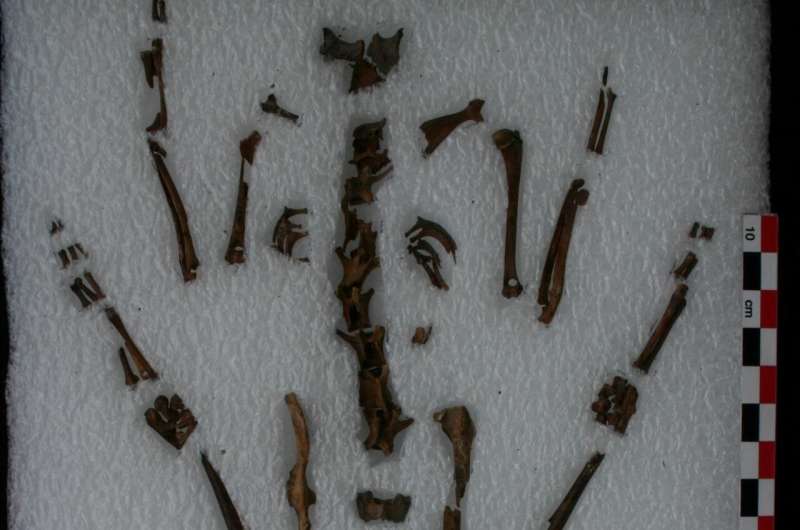Why weren't New World rabbits domesticated? Archaeologists find the answer in rabbit social behavior

Domesticated rabbits come in all sizes and colors, including tiny Netherland Dwarfs, floppy-eared French lops, Flemish Giants, and fluffy Angoras.
These breeds belong to Europe's only rabbit species, originally limited to the Iberian Peninsula and Southern France and used for meat and fur since the last Ice Age, culminating in domestication about 1,500 years ago.
The Americas, on the other hand, have many rabbit species with ranges throughout both continents. The archaeological record shows rabbits were used as extensively in the Americas as they were on the Iberian Peninsula, with clear archaeological evidence that rabbits were being deliberately raised. Why, then, were rabbits domesticated in Europe and not the Americas?
Recent work by archaeologists Andrew Somerville of Iowa State University and UC Riverside's Nawa Sugiyama found a simple answer: European rabbits live readily in large social groups while American cottontail rabbits do not. The less social nature of American cottontails combined with greater species diversity created a situation where rabbit husbandry did not lead to domestication.
Sugiyama looked to Teotihuacan, a major city in Mexico about 2,000 years ago, where cottontail rabbits comprised 23% of the animal remains during the Classic period. This was more than any other animal used for meat, including wild deer, as well as domesticated turkeys and dogs. The proportion of rabbit bones increased toward the city center, suggesting they were probably being raised, not hunted.
Rabbits were buried at the Sun and Moon Pyramids and are found in the stomach contents of sacrificial carnivores, such as eagles and pumas. Rabbit bones found in the carnivore stomachs contain a type of carbon that indicates a diet unusually rich in corn or cactus, suggesting human-raised rabbits had, in turn, been fed to the carnivores.
"The rabbits were probably fed corn, but the carbon isotopes don't distinguish between corn and cactus, so we can't say for certain," Sugiyama said.
Moreover, 46% of the animal bones excavated in one apartment compound were from rabbits that had been fed a similar diet of agricultural crops, and the amount of phosphate in the floor of one room indicates a location where rabbits urinated and were probably housed. A stone statue of a rabbit was also found in the complex's central plaza, reinforcing the importance of rabbit husbandry to the residents.
A thousand years later, the 16th century Spanish conquistador Hernan Cortez described the sale of rabbits at the Aztec marketplace of Tlateloco. Over at least a millennia of husbandry and extensive use for food, fur, and ritual, however, the rabbits of Mexico did not become domesticated—a mutualistic, multigenerational relationship characterized by human-controlled reproduction.
To understand why, Somerville compared the behavioral ecology of European rabbits and American cottontails against criteria that "prime" or preadapt animals for domestication. Animals that have been domesticated usually live in groups with resident males. They also have young that imprint easily and require parental care, a promiscuous mating system, tolerance for a wide variety of environments, and low reactivity to humans.
European and American rabbits were similar across all criteria except social behavior. European rabbits live in underground family burrows, called warrens, of up to 20 individuals that include males, who defend their breeding territory from other males. Warrens made it easy for people to locate and manage wild rabbit populations, then mimic those conditions in captivity, where rabbits readily reproduced.
American cottontails, on the other hand, are solitary, live entirely above ground, and tend to fight in enclosures together. Males do not defend a breeding territory and pursue more opportunistic mating strategies.
Somerville and Sugiyama conclude that their solitary nature, tendency to fight in enclosures, dispersed territories, and less predictable mating systems made it possible to raise rabbits without forming the kind of mutual relationship that would eventually give humans enough control over a species to direct its evolution. Greater species diversity also made it less likely that any one of them would become domesticated.
More information: Andrew D Somerville et al, Why were New World rabbits not domesticated?, Animal Frontiers (2021). DOI: 10.1093/af/vfab026
Provided by University of California - Riverside


















